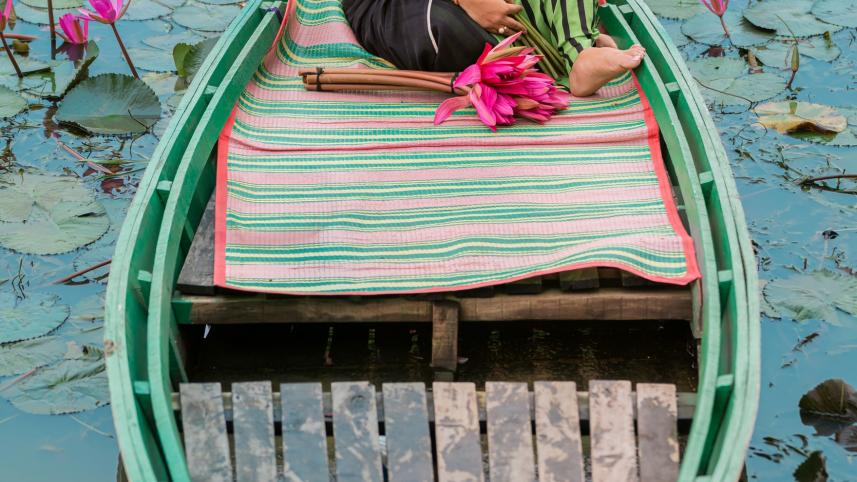Destination Swarupkathi

Our destination was Swarupkathi Upazila, in Pirojpur district of South-western Bangladesh. A lingering myth in this region is that the second son of Shah Shuja, Firoz Shah, died in this area and to honour him, the area started being called 'Firozpur.' In time, the pronunciation for 'Firozpur' slowly transformed to 'Pirozpur.'
The word Swarupkathi means "beautiful port," now officially named Nesarabad (since the Ershad regime), after Haji Nesaruddin, Pir Saheb of Sarsina – a renowned Islamic scholar from the area.
We left Sadarghat river terminal aboard a three-storied modern vessel, M.V. Agradoot, in the evening. After about two hours, as we cruised into the Mehgna, we enjoyed dinner with prawn curry, chicken curry, mixed vegetable, beef bhuna and all types of bharta.
In the morning, as we left the Meghna behind and navigated through the Sandhya river, we were charmed by the mesmerising beauty of the countryside dotted with coconut, betel and banana plantations. It was a delight to find dolphins displaying their playful nature in the middle of Sandhya River.
We reached Indurhat (Miarhat) river terminal in Sutiakathi the early morning. We were impressed to find that Sutiakathi was very progressive and developed; absolutely clean with intricate network of canals amidst the dense forest with all urban facilities. The very first morning, we went on a canal cruise to Atghar Kuriana – famous for the guava garden and floating market. The entire landscape portrays a serene natural ambience with an intricate network of rivers, estuaries, canals and a huge marshland. The area is highly forested with mahogany, teak, sal, garjan, rain tree (rendy) and Chambal, as well as fruit bearing trees such as hog plum (aamra), guava, elephant apple (chalta), Indian persimmon (gaab), wax apple (jamrul) and bananas. The area is equally famous for betel leaf and betel nuts. We came across some fishermen catching fish and boats loaded with goods of all kinds, destined for various places.
We saw logs of wood being towed along the river. The calm, tranquil water in the canals, with swaying coconut and betel plantations along the banks, was indeed soothing.
The following morning, we headed to Sutiakathi's floating market, famous for its tree saplings, fruits, and vegetables. Almost all the items are traded on boats, like fish, timber and coir (coconut fibre) products.
I found the age-old floating market very vibrant and colourful and close to nature. To our surprise, we also came across a booming ship building industry in the area that most of the country doesn't know about!

The region is a haven for fish lovers. However, the bulk of the fish caught here, such as hilsa, pangash, koral and varieties of fresh water fish such as Ayr and rui are destined for Dhaka and abroad. While there, we had our fill of some mouth-watering fish dishes, such as hilsa with mustard and prawn, ilish pulao and small fish wrapped in banana leaves, and nearly all of them cooked with coconut milk.
Traditionally, the area has attracted timber merchants from afar. This trade goes back hundreds of years. Some of the desirable logs available here include of sal, teak, lohakath and garjan. The proximity of the Sundarbans has also contributed to the growth of the timber industry. Swarupkathi is also known for its business centre and also the sundari tree (a kind of mangrove) that grows there.
I was told by a local that wood purchased in Guwahati, Assam and Darjeeling were towed down the rivers before finally reaching Indurhat. Houses, boats, furniture and various sports goods such as cricket bats, carrom boards etc. are all produced from wood sold locally.
We embarked on another canal cruise to Boithakata through Shohagdal. Across the Sandhya river, we availed a three-wheeler that brought us to the Dargah of Sarsina Peer Saheb. Later, we visited some of the nurseries on the Swarupkathi – Barishal highway. Miles after miles of fruit, flower and vegetable nurseries added to the beauty of the panoramic landscape. Interestingly, a lot of the nurseries in Dhaka are owned and manned by people from Swarupkathi. Further down, we visited the mosque at Guthia – possibly the finest mosque in the country.
Later, we got to relish hot succulent roshogolla, jilapi, pithas made of coconut, and tea prepared with fresh cow milk in possibly one of the most vibrant and colourful bazaars in the countryside.
Swarupkathi has one of the highest literacy rates in the country. Traditionally, proximity of Kolkata through the now-redundant steamer route, and the contribution from dedicated teachers in the area is largely responsible for the spread of education in the area.
Sutiakathi can only be reached by waterways from Dhaka and the rest of the country. Only recently, three-wheelers and motorcycles have started plying the roads, much to the annoyance of the local populace in an otherwise calm, tranquil area. The area deserves to be recognised as a destination for eco-tourism and it is imperative that public and private enterprises put serious thought and consideration for the locals and the culture in the area.
Photo: Shamim Ahmed




 For all latest news, follow The Daily Star's Google News channel.
For all latest news, follow The Daily Star's Google News channel.
Comments